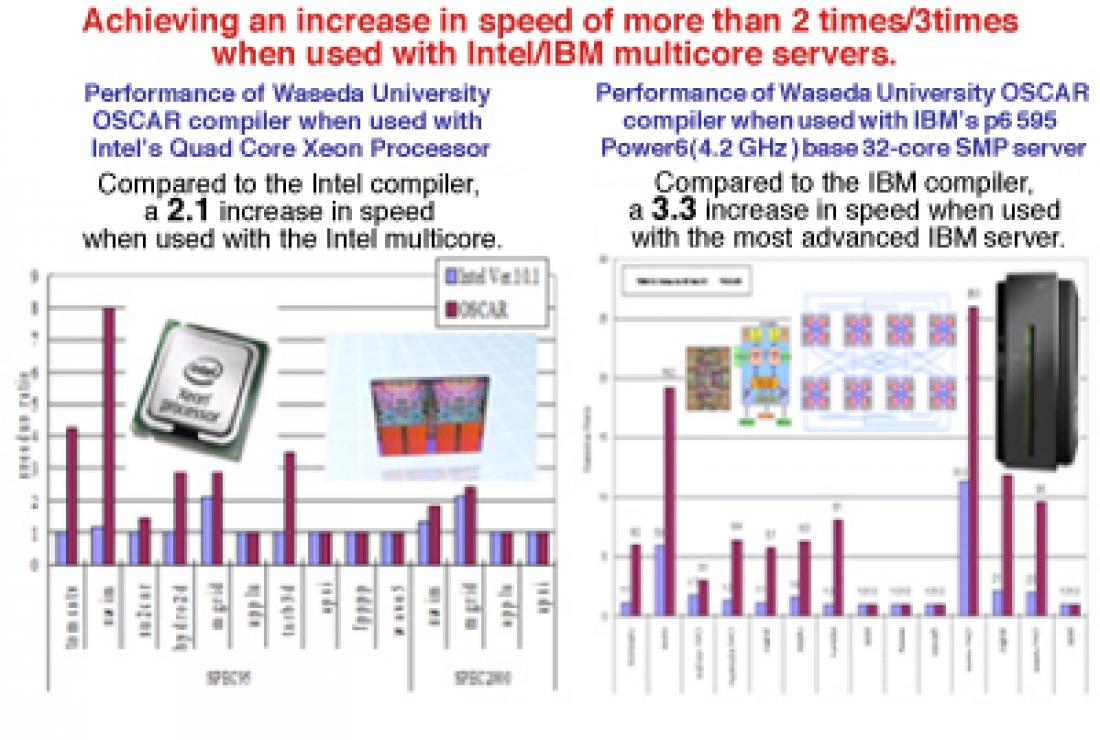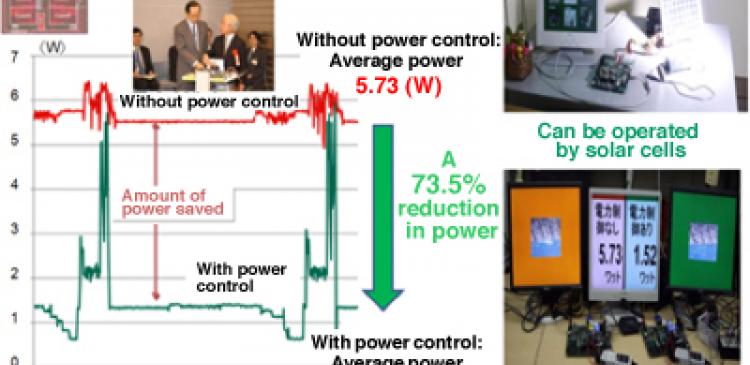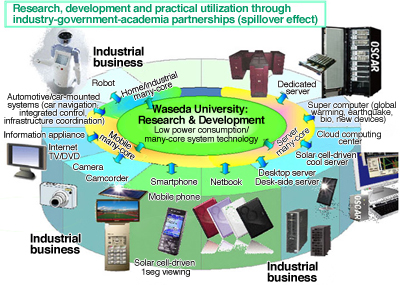Figure 1: The world-leading performance of the OSCAR compiler
<Before reproducing in any form, please read the copyright notice at the end of this article>
Green Computing Systems Research Organization
Upon entering the 2010s, the two main pillars of Japan’s strategy for existing as a world leader in science and technology are “life” and “green.” Life refers to science and technology related to health and life in an aging society. Green refers to science and technology for suppressing global warming and for establishing a low-carbon society which breaks away from the dependence on fossil fuels of the 20th century.
In particular, the latter theme of green is a priority field that composes half of the Japanese government’s budget for science and technology. Furthermore, actions are being taken in a wide range of fields in order to realize “green innovation”, which is a new keyword of environmental policies which further advance the themes of eco and green. Green innovation is a current worldwide trend in which countries seek to break away from a 20th-century economic society which relied on fossil fuels and to effect a more fundamental innovation for establishing a new economic social system.
An important field within green innovation is green IT, which is an approach for achieving a high level of energy efficiency and improving productivity through technological development in the fields of information and electronics. Due to the continuing trend of informatization, the amount of information handled by society as a whole is predicted to increase by approximately 200 times in 2025 (compared to 2006). It is forecasted that this explosive growth of information society will increase the power consumed by IT devices and system from 47 billion kWh (2006) to 240 billion kWh in 2025. This is a massive increase of nearly 5 times. Even as we seek effective and efficient technology for utilizing computers to benefit human society, we are confronted with the important issue of efficiently managing the power consumed.
In 2009, Waseda University took action to establish a research and development center which would lead Japan’s green innovation in the IT field through a partnership between industry and academia. Our university secured a Grant for Establishing Industrial Technology Research & Development Facilities (Project for Establishing Advanced Innovation Centers). This grant was part of competitive research funding awarded by the METI (Ministry of Economy, Trade and Industry) in 2009. Funding was also supplied by Waseda University and the Green Computing Systems Research and Development Center was established in April 2011 on Kikui-Cho Campus, located nearby the Waseda Campus. The advanced research environment and facilities of the center provided a starting point for full-scale innovative activities. Additionally, the Green Computing System Research Organization was established in November 2010 as a research organization that fulfills a central role in the research and development.
We discussed the aspirations of this project with Professor Yuichi Matsushima (Center for Research Strategy), Director of the Green Computing Systems Research Organization, and Professor Hironori Kasahara (Faculty of Science and Engineering), Project Leader of the Green Computing Systems Research and Development Center.
Based on multicore technology with the world’s highest level of performance
“Originally, the Information Technology Research Organization was established at Waseda University in June 2004 as an organization to strategically promote research and development in the information and communications fields. Joint research has been conducted through total cooperation from faculty on all campuses, including the Honjo Campus and Kita-Kyushu Campus. This joint research led to the independent establishment of 2 project laboratories, the Advanced Multicore Processor Research Institute and the Perceptual Computing Laboratory. Then, the Global Software Engineering Laboratory was newly added to the two existing laboratories in order to form the Green Computing Systems Research Organization.” (Professor Matsushima)
The impetus for the establishment of the Green Computing Systems Research Organization was the overwhelming superiority of the advanced multicore processors which form the organization’s central research field. In addition to working to realize a multicore in which multiple processors are integrated on top of single chip, Project Leader Professor Kasahara is developing a next-generation ultra-high integration multiprocessor known as a many-core. This many-core features high integration of 64 cores/128 cores/256 cores. In his quest to achieve these research goals, Professor Kasahara has realized parallelized compiler technology which boasts the world’s highest level of performance, as well as control technology which enables ultra-low power consumption.
Upon entering the 2000s, there was heightened momentum to establish government projects in Japan for developing parallelized compilers and multicore processors for information appliances. From 2000, Professor Kasahara began to participate in government projects consisting of joint industry-academia research with Hitachi, Fujitsu and other leading companies in the computer industry. Through such projects, Professor Kasahara has conducted research and development which seeks to establish competitive advantages for Japan.
“The current project is based on technology with the highest level of performance in the world. This technology has been established through our efforts over the past 10 years. In addition to developing next-generation many-core processor technology, the project also conducts applied development in order to create products which utilize such processor technology. It is difficult to realize competitive advantages in industry simply by developing general-purpose processor technology. In order to transform the superiority of outstanding technology into concrete advantages in market and profit, it is necessary to conduct effective transfer of technology. By including industry-academia partnerships which feature joint research with manufacturers of information appliances and automobiles, we seek to quickly develop processors and their software which are intended for strategic product development. This will enable us to secure a high market share and high profit in global fields which Japan specializes in.” (Professor Kasahara)
The central research fields of the project will be based on past successes such as automatic parallelized compiler technology which boasts the highest level of performance in the world, as well as parallelized program generation technology used in the world’s only processor to control power consumption at the time of a single application program execution. Furthermore, there is a plan to focus on research and development in the following 4 areas: (1) next-generation ultra-low power consumption multi/many-core processor technology, (2) realization of servers which utilize such processor technology, (3) parallelized compiler technology for multi/many-core processors, and (4) API (application program interface) for many-core.
The project will create spillover effects by organizing projects consisting of industry-government-academia partnerships. These projects will address not only to fundamental technologies, but also to research and development for application to information appliances, medical image processing, automobiles, robots, cloud servers and ultra-high performance computers. Joint research has already begun with companies such as Hitachi, Fujitsu, Renesas Electronics, NEC, Olympus, Denso, Toyota and Mitsubishi Electric.
Additionally, former Waseda University President Katsuhiko Shirai is one of the project members. Dr. Shirai has worked tirelessly to start the research organization. His participation will aid the organization in exploring applied research for fields in which Waseda University specializes; namely, voice recognition processors in nursing care robots for the elderly and software engineering for safe and secure information/telecommunications.
Towards the practical application of processors which work using solar energy
The Green Computing Systems Research and Development Center which was completed in April 2011 consists of 8 floors, including the roof. The 2nd floor server room is equipped with two parallel computers which possess the highest performance in the world. The SMP (symmetric multicore processor) machine is one of the largest in the world and contains advanced processors from both Japan and America. Featured are Fujitsu’s M9000 Sparc VII 256 core SMP and a Power 7 128 core SMP which was jointly developed by Hitachi and IBM.
Furthermore, power is supplied to the 2nd floor server room from solar panels which are installed on the 8th floor roof. Demonstration experiments using chips and cloud computing are being conducted in an effort to realize practical application of computer technology which is operated using solar power and consumes low amounts of power. “We have conducted this research for some time now. However, considering the recent earthquake, I strongly feel that we must act quickly to realize the practical application of mobile phones and mobile terminals which can be operated stably using solar power.” (Professor Kasahara)
A large number of researchers from joint research corporations are participating in the project as Visiting Professors and Invited Researchers. The 3rd to 7th floors of the center consists of research space. In particular, the 3rd and 4th floors are for joint industry-academia research and feature heightened security. These two floors also contain space which can be used as residences by joint research corporations. “When conducting research and development which is closely linked to commercial products, it is necessary to construct a research environment which can protect corporate secrets. The center contains an environment in which corporate researches can engulf themselves in joint research with peace of mind. Such an environment cannot be found on normal university campuses.” (Professor Kasahara)
An international patent strategy is also important in order to secure international competitive advantages. Staff members responsible for joint research contract management and intellectual property management are positioned at the center. This creates an environment in which researchers can focus solely on their research. “As a joint research center specializing in industry-academia partnerships, it was our goal to provide an outstanding research environment. We want to do our best and provide everything that a university can offer. I believe that it is a new challenge for Waseda.” (Professor Matsushima)
The 1st and 2nd floors of the center contain presentation rooms so that international conferences and seminars can be held. The 2nd floor presentation room seats 100 people, while the 1st floor room can accommodate 160. An international conference on green computing featuring attendance from the world’s top researchers is scheduled to be held in September 2012.
“Another important pillar of the center is the cultivation of professionals through participation in this type of advanced joint research. Graduate students will perform their doctoral studies at the center. The goal of our project includes helping such students to gain employment as corporate researchers and to contribute to creative development of technology.” (Professor Matsushima)
Green innovation expands beyond mere suppression of global warming and conservation of energy and resources. Indeed, green innovation is the basis of a sustainable socioeconomic system in the 21st century. “Of course, we have the strategic goal of linking Japan’s high technological ability to the creative development of products. However, even more importantly, our green computing system is technology that will contribute to protecting and prolonging the existence of life on our planet. We will actively work to apply this technology to the medical field and to disaster prediction simulations.” (Professor Kasahara)
Waseda University’s green computing system links the world’s highest-performing fundamental technology to the competitive industry of Japanese industry. The system also contributes to the formation of a sustainable global society. During the next 10 years, the goals of this project will steadily become reality.
======================================
【Copyright Notice】
All of the articles, images, photographs and other content displayed above are owned by Waseda University. Permission to reproduce any content is subject to the following Terms of Use.
Terms of Use
- Content may not be used in a manner that may harm the honor or reputation of Waseda University.
- When reproducing any content, you must request permission by notifying the Office of Information and Public Relations of Waseda University through e-mail ([email protected]) and indicate the title of the media and intended date of reproduction. Unauthorized reproduction is strictly prohibited.
- Please cite clearly the source of content at the end of each article using the following format (Source: ResearchSEA yyyy/mm/dd).
- Content may not be altered or modified in any way. Manipulation of photographs is strictly forbidden. Use of quotations as protected under copyright law is limited to summarization or quotation of the main point.
- Use of content is protected under the copyright law. Any claims or disputes, privacy issues, or other matters related to copyrighted content not owned or controlled by Waseda University becomes the sole responsibility of the user.





